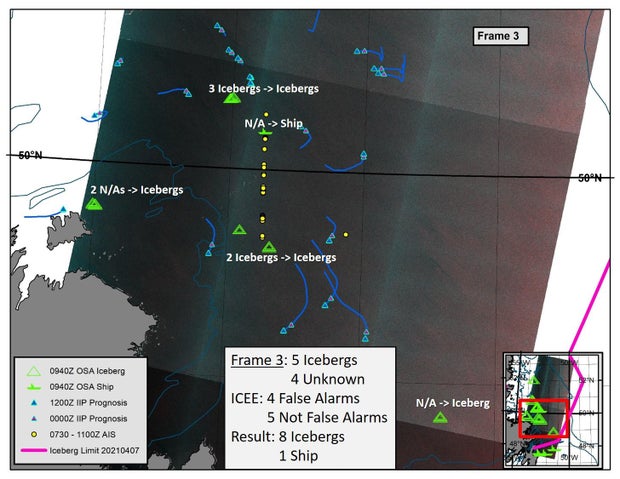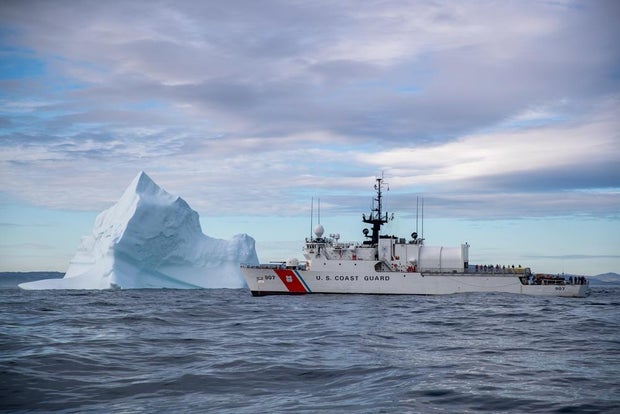[ad_1]
It was the “unsinkable ship” until it wasn’t.
10 minutes right before the maiden voyage of the Titanic ended in calamity, a radio operator aboard the close by SS Californian signaled that there was an iceberg in the ship’s path. The warning was dismissed, and the huge collision that followed price around 1,500 lives, prompting a wave of maritime innovations: sonar and radar navigation functions, lifeboat drills and the development of the Intercontinental Ice Patrol (IIP.)
Now, 110 a long time just after the sinking of the Titanic, the U.S. govt is acquiring a new technology that’s built to detect and report icebergs to the maritime neighborhood.
“Procedure Titanic,” spearheaded by the Division of Homeland Security’s Science and Know-how Directorate, will fuse satellite-centered radar imagery with ship reporting programs to empower the U.S. Coast Guard to discover glacial masses throughout the North Atlantic Ocean in true time.
Presented by U.S. Coast Guard
Floating icebergs like the a person the Titanic struck on April 15, 1912, however pose navigational dangers now for ships, oil rigs and military services belongings, suggests Kathryn Coulter Mitchell, the DHS senior formal executing the duties of the beneath secretary for science and technology, explained to CBS Information.
“The Titanic essentially struck the iceberg at a latitude equivalent to the Massachusetts region,” Coulter Mitchell reported. “Those of us in this mission house don’t usually realize just how much south, how widespread the iceberg mission is.”
The 16-human being IIP is funded by 17 nations bordering the trans-Atlantic, but is operated by the U.S. Coast Guard for the duration of ice season, from February by way of July.
The patrol at first relied on cutters deployed by the U.S. Coastline Guard to study icebergs but switched to aircraft monitoring immediately after Globe War II. Now, the IIP pilots 9-working day plane missions just about every two weeks.
Presented by U.S. Coastline Guard
“Procedure Titanic” will mark a “total departure from [U.S. Coast Guard’s] several many years of traveling fixed-wing aircrafts to find icebergs,” said Coast Guard Commander Marcus Hirschberg with the Global Ice Patrol. .
Supplied by U.S. Coastline Guard
“Aerial ice reconnaissance” routinely provides up to a lot more than $10 million in yearly costs for the U.S. Coastline Guard. Further than the selling price tag, C-130J aircrafts that fly bi-weekly missions – about 500 aircraft hrs per time – are also the U.S. Coast Guard’s most really sought immediately after aviation belongings.
“We are heading to get a great deal additional bang for our buck once we can use all those plane hours for disaster reaction, counterdrug operations, migrant functions and other places,” Hirschberg included.
The U.S. government has invested $4 million in “Procedure Titanic” to date, with income drawn from the Science and Technology Directorate’s Investigation, Improvement and Innovation fund.
And although similar systems are presently utilised by the U.S. government in rescue missions and flood reaction, the new satellite engineering – which will attract images from the European Space Company satellites, U.S. industrial vendors and Canada’s RADARSAT Constellation – will be the first of its type to obtain world wide satellite information.
The satellite-centered radar imagery continues to be fully operational in darkish, overcast conditions that often avoid standard plane functions. Hirschberg named it a “match-changer for forecasting the season.”
“When the Coast Guard arrived to us with this, the hope was to triumph over the issues with [technology] that is immune to darkness and overcast, so we can see even further upstream of the transatlantic shipping and delivery strains than we at any time have been in advance of to issue for a longer period-phrase predictions,” Coulter Mitchell claimed.
“For forecasting, we are seeking at icebergs that are way considerably North that we are not able to access with aircrafts, even traveling from St. John’s Newfoundland,” reported Hirschberg.
“A ton of occasions you can find a mechanical concern with the airplane, inclement weather, or we won’t be able to get the hangar doorway open for the reason that of significant winds. So we do drop a whole lot of possibilities to fly,” he added.
Glaciers in components of the North Atlantic are melting so promptly that variations can be seen from house. The most up-to-date “Arctic Report Card,” printed by the National Oceanic and Atmospheric Administration (NOAA), discovered the region warms two times as rapid as the relaxation of the Earth, ensuing in the immediate reduction of ice cover.
“We see so substantially period-to-period variability,” Hirschberg explained to CBS Information. “In 2019, we had 1,500 icebergs pass south of 48° North latitude – about where by the Titanic sank. In 2020, we experienced a single iceberg move that restrict.”
U.S. Coastline Guard officials anticipate using satellite photographs will enable the department navigate alterations brought on by a transforming weather.
The Global Ice Patrol is slated to check-operate “Operation Iceberg” for two years, beginning in 2023 just before launching the program.
[ad_2]
Resource connection








More Stories
How To Promote Direct Hotel Bookings
My 50th birthday celebrations in Amsterdam
5 Ways to Improve Hotel Operational Efficiency